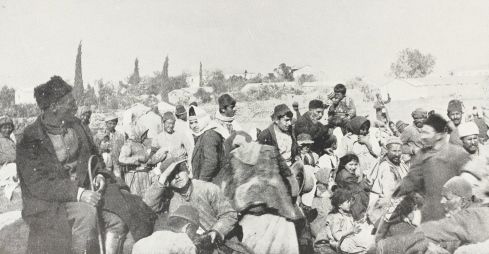
During the raid against Amman, the town of Es Salt was captured by the 3 Light Horse regiment, and occupied in strength by the 60 Division. On the withdrawal of the British, large numbers of Christian inhabitants of Es Salt, fearing massacre, abandoned their homes and withdrew with the force, Australian War Memorial, A302, copy from Charles Bean Vol 12, 1 Edition.
On 27 March 1918, the 4 Battalion of the Camel Brigade (Australian and New Zealand), under Lieutenant-Colonel A. J. Mills, was sent beyond the New Zealand position and on to the railway south-east of Amman. They at once began a systematic destruction of the line and with the assistance of the Wellington Regiment destroyed several miles of rails with explosivesThat night their commander Chaytor ordered the 2 Light Horse Brigade to make a second attempt to cut the railway to the north.
Bolingbroke, of the 9 Light Horse, marching in the darkness with two squadrons over very rough country, reached the railway about 7 miles from Amman. There a two-span stone bridge about thirty feet long was reached and completely wrecked by Lieutenant H. A. Lockington, of the New Zealand Engineers. After an absence of seven hours, the party returned to the brigade at 5 a.m. on the 28th. Amman was now temporarily isolated; but the first day’s fighting had convinced Chaytor that the position could not be reduced by his slender mounted force alone.
Already there had been over 200 casualties, and, although a few Turks had been captured, the enemy position had not been in the least shaken. While the mounted force was climbing up to the plateau by the tracks to the south, Es Salt had been won without fighting by the 3 Light Horse Regiment under Bell, and the 60 Division quickly followed by the main road.
Research and Collection Services, City of Parramatta, Heritage Centre, 2018
References
The biographical information has been researched and compiled from the following resources:
- Australian War Memorial – https://www.awm.gov.au/
- Commonwealth War Graves Commission – http://www.cwgc.org/
- National Archives of Australia – http://www.naa.gov.au/
- National Library of Australia Trove Digitised Newspapers Database – http://trove.nla.gov.au/newspaper
- Parramatta and District soldiers who fought in the great war, 1914-1919. (1920). Parramatta, N.S.W. : The Cumberland Argus Ltd. – https://drive.google.com/file/d/0B9iAn5sxT0i8ZHgyZjR2UHRxVUU/edit
- The National Archives (UK) – http://www.nationalarchives.gov.uk/
- University of New South Wales Canberra The AIF Project – https://www.aif.adfa.edu.au/index.html


